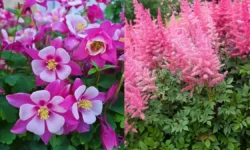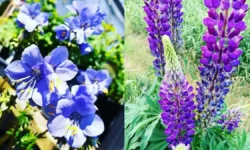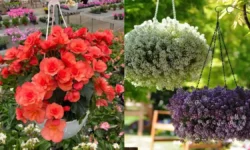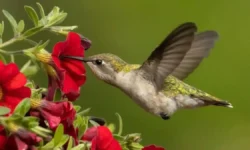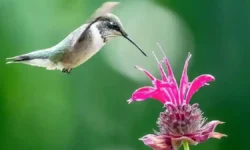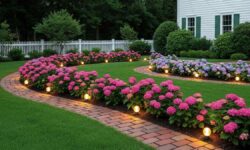If you want huge, fluffy blooms without babysitting, this guide on how to care for hydrangeas outdoors keeps it practical—what to plant, where to plant, and how to water, feed, prune, and protect through every season. I’ll keep the instructions clear and human, not fussy. You’ll also see quick fixes for color (blue vs. pink), bud-saving pruning, and the best soil + light mix for steady flowers year after year.
Table of Contents
How to care for hydrangeas outdoors: quick-start checklist
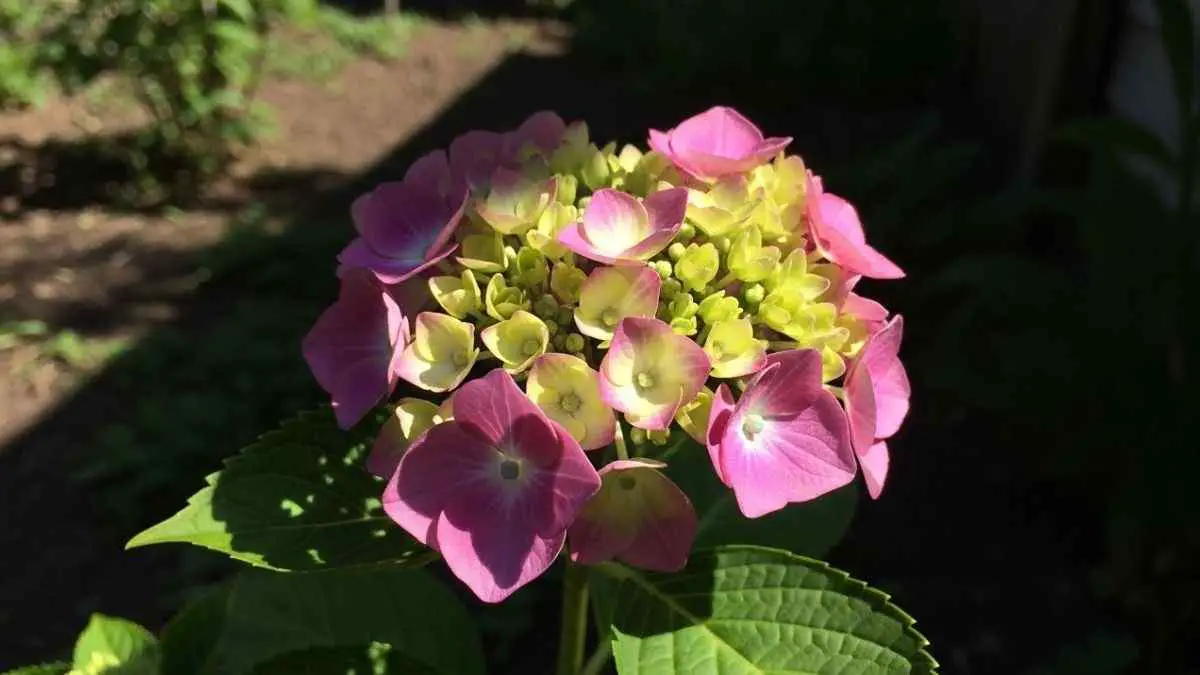
- Light: Morning sun with afternoon shade is the sweet spot for most kinds. Panicle hydrangeas handle more direct sun if they’re watered well.
- Soil: Moist but well-drained, rich in organic matter. Aim near pH 6–7 (bigleaf color shifts with pH).
- Water: Deep soak 1–2 times per week in the growing season; more during hot spells if soil dries. Avoid soggy soil.
- Planting time: Late spring or early fall so roots set before temperature extremes. Dig a hole twice as wide as the pot, same depth.
- Feeding: Light, balanced feeding in spring; don’t go heavy on nitrogen.
- Pruning: Know your type. Old-wood bloomers (bigleaf, oakleaf) after flowering; new-wood (panicle, smooth) late winter or very early spring.
- Winter: Mulch roots; in colder zones, wrap or cage buds on old-wood types to prevent freeze damage.
Tip: when in doubt, prioritize even moisture + morning sun. That alone fixes like 70% of issues, for real.
Choose the right hydrangea (makes outdoor care easier)
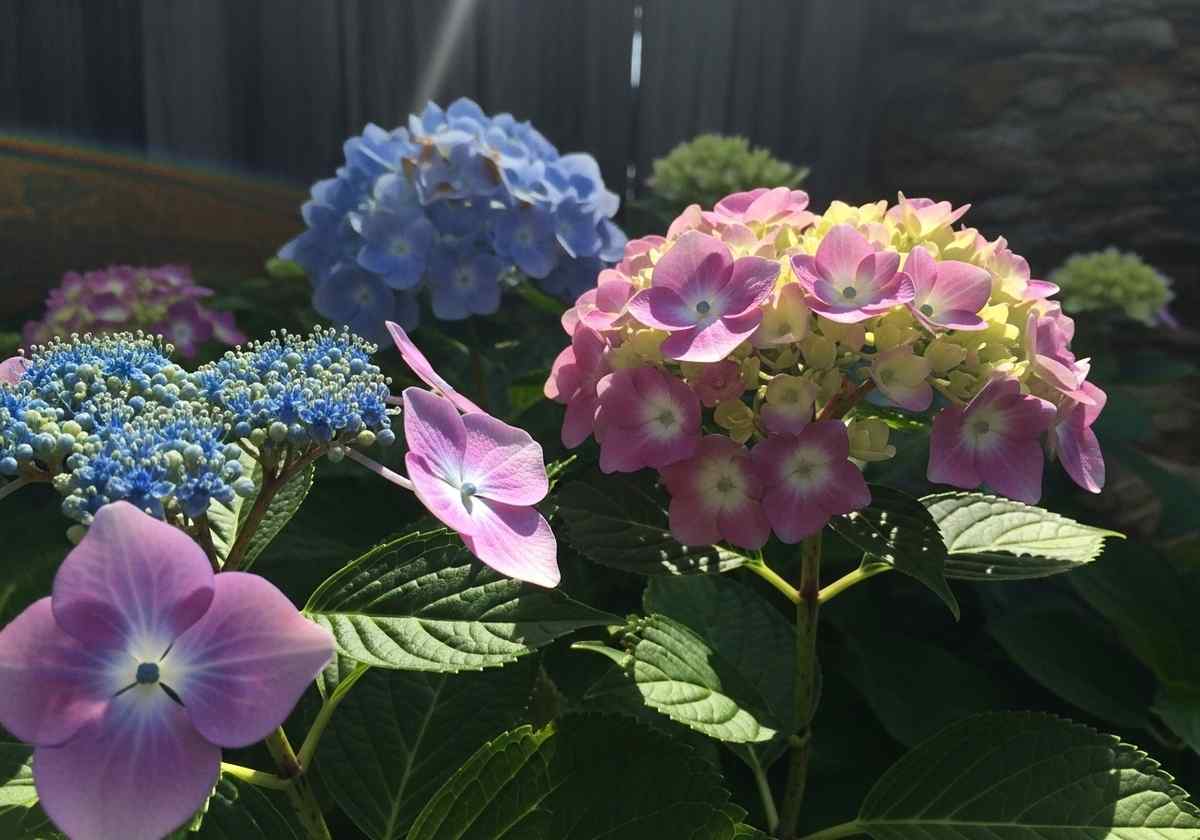
Match the species to your yard
- Bigleaf/Macrophylla (mophead + lacecap): Iconic blues/pinks, best in part shade. Buds on old wood; protect in winter.
- Mountain/Serrata: Lacecap blooms, a bit tougher in cold than some bigleafs; also old wood.
- Panicle/Paniculata: Cone-shaped blooms, the most sun-tolerant; bloom on new wood (low stress pruning).
- Smooth/Arborescens (e.g., ‘Annabelle’): Big white heads, very forgiving; bloom on new wood.
Why this matters for how to care for hydrangeas outdoors: Light needs and pruning time change by type. Get those two right and your shrubs reward you like crazy.
Best planting time & method (set them up once, thank yourself later)
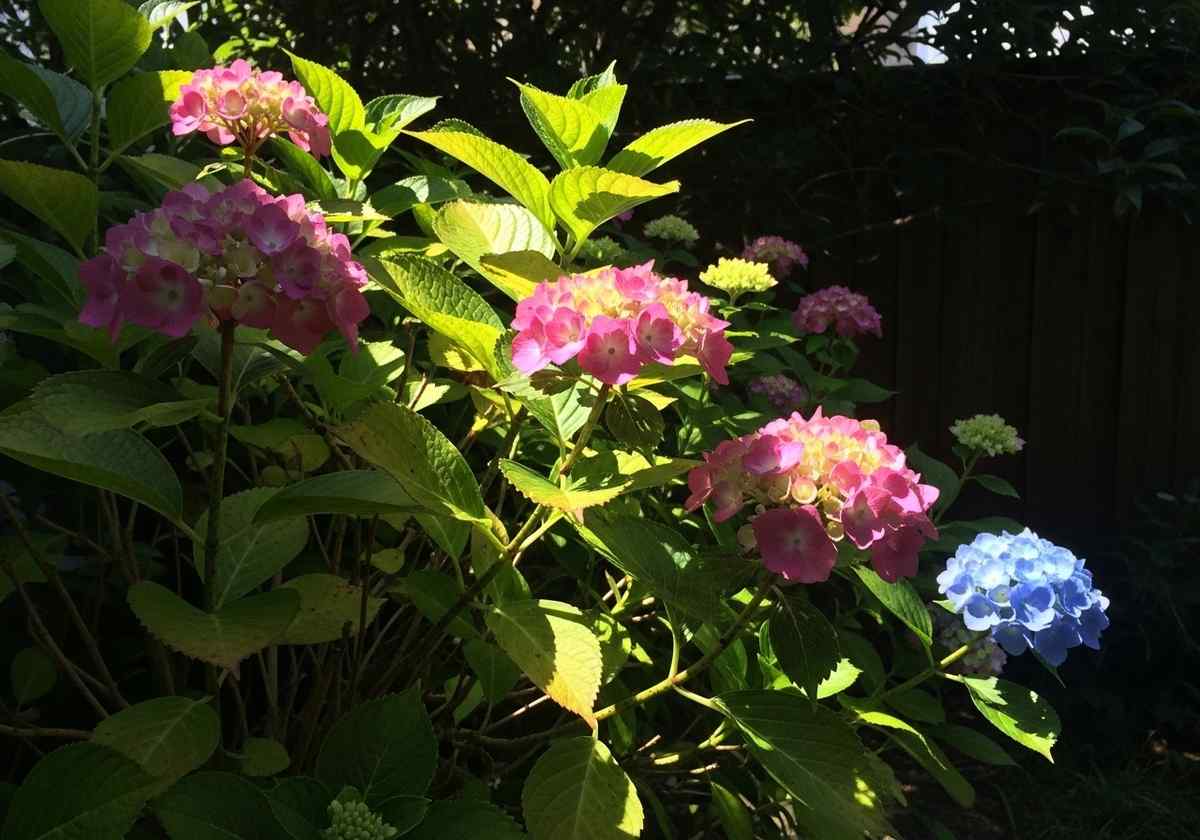
When to plant outside
Plant in late spring after the soil warms, or early fall so roots settle before heat or deep cold. Avoid setting a baby plant right before a heatwave or hard freeze.
How to plant hydrangeas in the ground
- Water the nursery pot so the root ball is evenly moist.
- Dig a hole 2× as wide as the root ball, the same depth as the pot line—don’t bury the crown.
- Tease loose any circling roots; set the plant at the same soil level it had in the pot.
- Backfill with native soil improved with compost (skip straight potting mix in the hole).
- Water deeply to settle. Mulch 2 inches thick (keep mulch an inch away from stems).
Pro move: On clay, blend in compost or leaf mold to improve drainage; on sand, add compost to hold moisture. Both cases—mulch helps a ton.
Sun, shade, and heat: the “just right” zone
How much sun outside?
Most hydrangeas bloom best with morning sun + afternoon shade. In cool regions, many tolerate more sun; in hot summers they’ll flag by noon without protection. Panicles tolerate the most sun if irrigation is steady.
Heat stress vs. true drought
Leaves can curl/wilt in extreme heat as a protective response, then recover by evening—don’t flood water if soil is still moist. Check 3–4 inches down; if it’s dry, water. If damp, wait. This tiny habit is central to how to care for hydrangeas outdoors without wasting water.
Soil, pH, and nutrition (yes, color control is real)
The soil hydrangeas actually want
- Texture: Loamy, moisture-retentive but well-drained.
- Amendments: Compost or leaf mold at planting; refresh yearly in spring.
pH and flower color (for bigleaf + some mountain types)
- Blue: more acidic soils (about pH ≤6) with available aluminum.
- Pink: neutral to alkaline (around pH 7+).
Use garden lime to raise pH (pink) or aluminum sulfate/sulfur to lower pH (blue). Change is gradual; test once or twice a year.
Feeding for blooms, not just leaves
A light, balanced feed in early spring is usually enough. Too much nitrogen = lush green + fewer blooms. If your soil is already rich, you might skip fertilizer entirely—seriously fine.
Water like a pro (the part most folks get wrong)
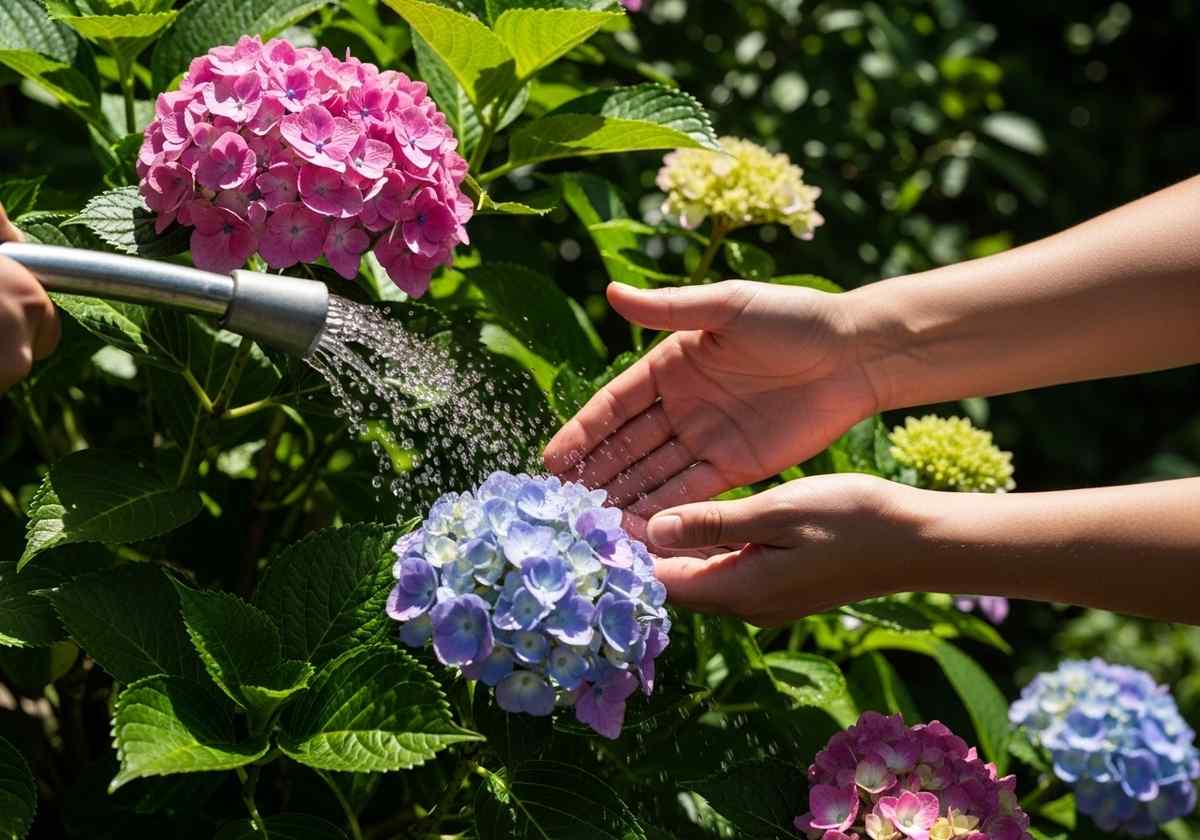
Weekly target outdoors
Plan on a deep soak 1–2× per week in the growing season. In heat waves, water only if the top few inches dry fast. Avoid daily shallow sprinkles; they never reach roots.
Tools & timing
- Soaker hose or drip beats overhead spray (fewer leaf spots, less waste).
- Morning watering reduces scorch and fungal risk.
- New plantings need consistent moisture their first season; older shrubs become a bit more drought-tolerant, but still want steady water in dry spells.
Keeping a simple rhythm like this is the heart of the best hydrangea care guide outdoors.
Mulch, spacing, and airflow (quietly critical)
Mulch rules
Add ~2 inches of shredded bark/leaf mold around the root zone, leaving a donut gap around stems. Mulch smooths moisture swings and cools roots in summer, insulates in winter.
Give them room to breathe
Space most shrubs 3–5 feet apart (variety dependent). Tighter spacing = more mildew and fewer flowers. Good airflow is part of how to care for hydrangeas outdoors that folks skip—please don’t.
Pruning hydrangeas outdoors (old wood vs. new wood)
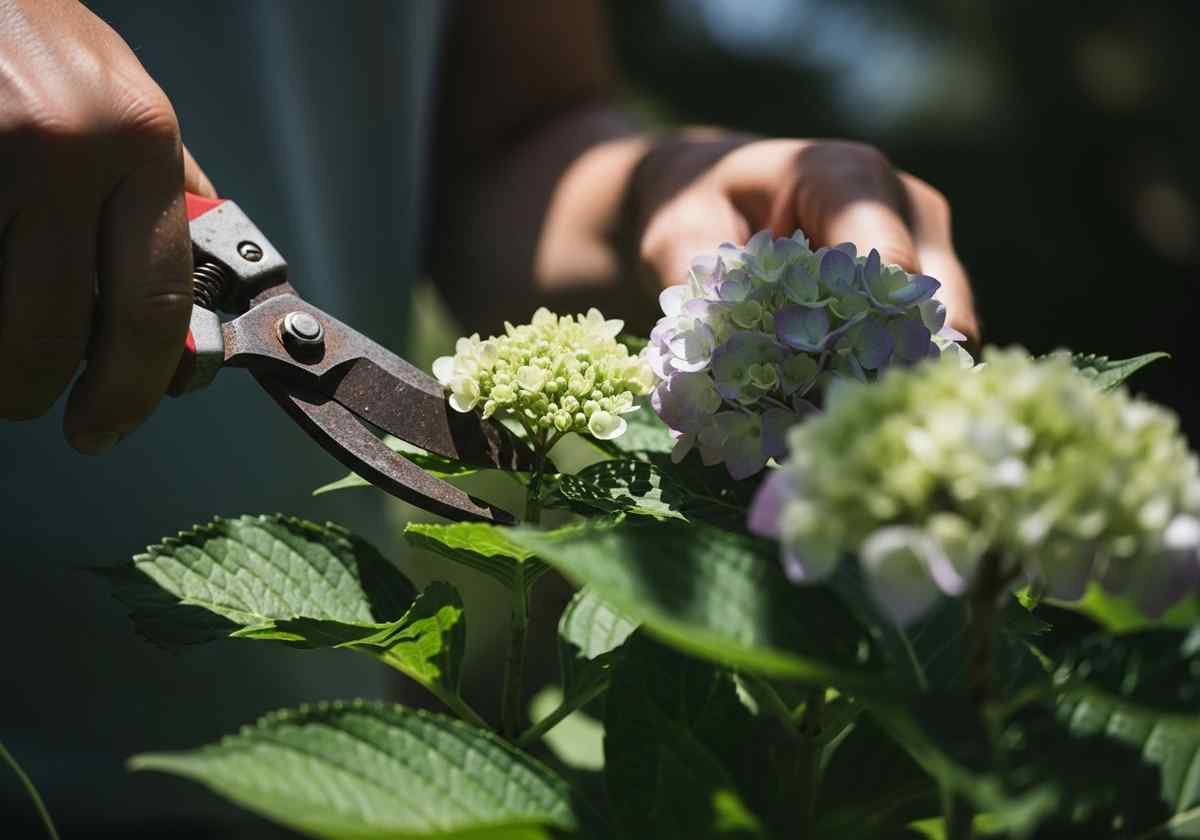
Who blooms on old wood?
- Bigleaf (macrophylla), mountain (serrata), oakleaf (quercifolia) form next year’s buds on stems that grew this year.
- When to prune: Immediately after flowering (mid–late summer). Cut out dead/damaged wood first, then lightly shape.
Who blooms on new wood?
- Panicle (paniculata) and smooth (arborescens) bloom on the current year’s growth.
- When to prune: Late winter or early spring before growth resumes. Reduce by up to one-third to shape and encourage sturdy new stems.
Easy rule you can remember
If you don’t know the type, do minimal pruning until you see when buds form. Better a slightly shaggy shrub than a bloom-less one next summer. This is simple but key for anyone asking how to care for hydrangeas outdoors without guesswork.
Seasonal care calendar (what to do, when)
Spring: wake-up and prep
- Clear winter mulch from stems; top up a fresh 2-inch layer.
- Feed lightly if soil is lean.
- Prune new-wood types now; leave old-wood types alone except dead wood.
- Begin pH adjustments (slow and steady).
Summer: water + deadhead (optional)
- Deep water during dry spells; check soil before adding more.
- Deadhead for tidiness (not required for re-bloom).
- Watch for leaf spot in sticky weather; water at soil level.
Fall: slow down
- Reduce supplemental water as rains return.
- Layer compost around the dripline to feed the soil.
- Start planning winter protection for old-wood types where freezes bite.
Winter: protect what matters
- For old-wood bloomers in cold/windy zones, build a wire cage and fill with dry leaves, or wrap burlap to buffer buds from freeze-thaw and windburn.
- Keep mulch on the root zone.
Color control, the safe way (blue vs. pink)
If you want blue
- Lower pH gradually and ensure available aluminum (often via aluminum sulfate as labeled).
- Test soil pH; re-test in 6–12 months. Changes are slow.
If you want pink
- Raise pH into neutral/alkaline with garden lime, a bit at a time.
- Avoid high aluminum availability. Monitor yearly.
Note: not every species shifts color. Bigleaf + some mountain types respond; panicles and smooth hydrangeas don’t really color-shift with pH. Good to know before you chase a shade that won’t happen.
Common outdoor problems (and the fast fixes)
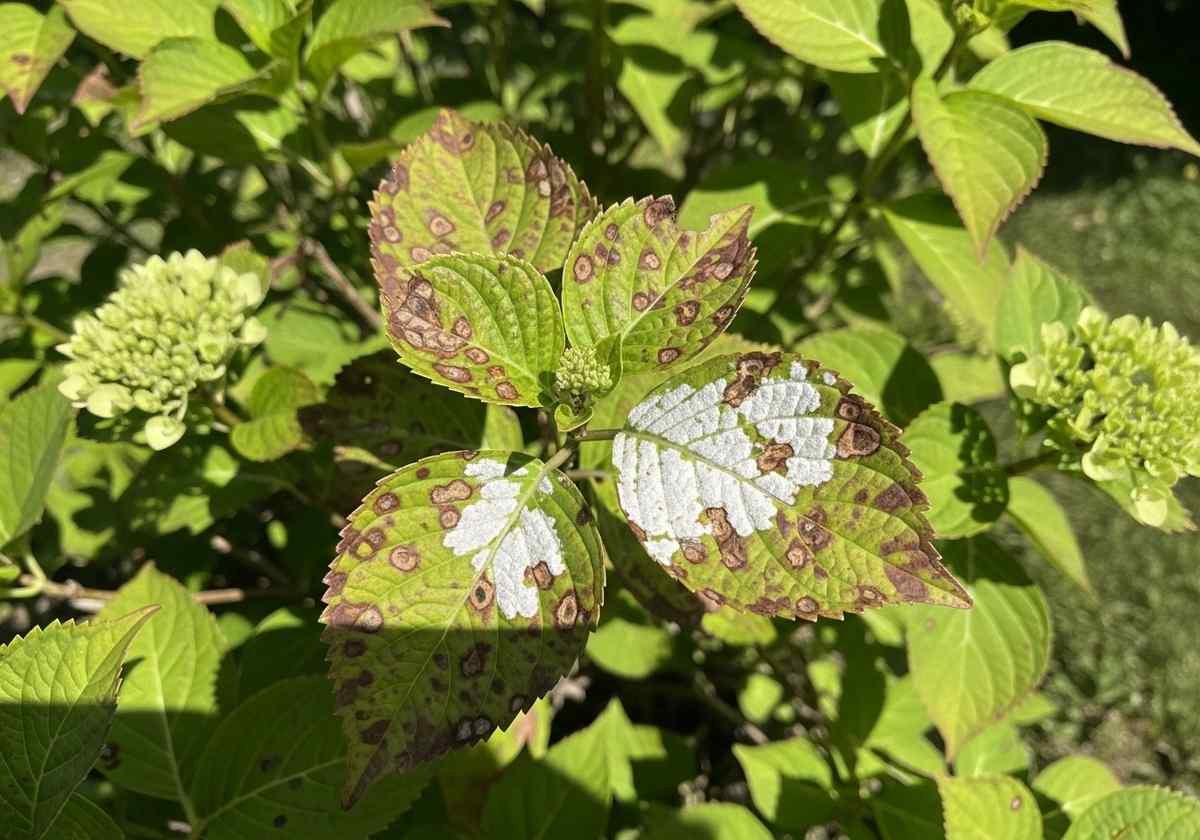
Wilting at noon, fine at dusk?
Probably heat stress, not immediate drought. Check soil 3–4 inches down. Water only if dry.
Few or no blooms?
Common reasons: wrong pruning time (cut off buds), too much shade, or excess nitrogen. Adjust one variable at a time. If you’re unsure, follow the best hydrangea care guide basics: sun in the morning, deep water, light feeding, correct pruning window.
Leaf spots or mildew?
Improve airflow, water at the base, and avoid overhead late-day watering. Copper or bio-fungicides can help in bad seasons, but cultural fixes usually win.
Buds zapped by winter?
Protect old-wood bloomers with a leaf-filled cage or burlap wrap where late frosts hit. If the spot is a frost pocket, consider moving the plant.
Deer, pets, and kids
- Deer are… not shy. Many hydrangeas are not deer-resistant; spring bud browsing ruins shows. Use fencing or repellents if deer pressure is high.
- Hydrangeas are toxic if ingested by people or pets—teach boundaries and supervise toddlers/pups outdoors.
Outdoor containers vs. ground planting (what changes)
Pots on porch, steps, or patio
- Pick dwarf varieties or compact types.
- Use a quality container mix (not garden soil) + slow-release fertilizer in spring.
- Water more often: pots dry way faster than beds.
- In winter, cluster pots in a sheltered spot or wrap the container to protect roots.
In-ground perks
- Deeper, cooler root run; less frequent watering; easier wintering.
- You still mulch, you still check moisture—but you’re not chained to the hose.
For renters or small spaces, containers are a legit way to care for hydrangeas outdoors and still get big color.
The best “daily” routine for how to care for hydrangeas outdoors
Weekly rhythm (growing season)
- Check soil with your finger (or a meter) mid-week.
- Water deeply if dry several inches down.
- Peek for pests/disease; remove spotted leaves from the plant + ground.
- Fluff mulch and pull weeds while you’re at it. Keeping it tidy = less disease later.
Monthly rhythm
- Eyeball spacing and trim encroaching plants to keep airflow.
- If blooms are heavy on smooth/panicle types, a light stake or support ring helps stems hold up after storms.
Mistakes to avoid (learned the hard way)
- Daily sprinkles instead of deep soaks. Roots stay shallow and stressed.
- Planting too deep. Keep the crown at the same level as the pot line.
- Shearing old-wood types in late winter. That’s basically a bloom eraser.
- Over-fertilizing with high nitrogen. Gorgeous leaves, missing flowers.
- Full, blazing afternoon sun without extra water or shade—especially for bigleafs.
These are simple, but this is honestly the best hydrangea care guide shortcut: avoid these, and most things just work.
Quick designs that make care easier (bonus ideas)
Easy border for busy folks
Line a path with panicle hydrangeas (sun-tough), underplant with hardy groundcovers (ajuga or sweet woodruff), set a soaker hose, and mulch. Minimal weeding, simple watering, great blooms.
Shade corner fix
Use bigleaf or mountain hydrangeas in dappled shade, add ferns or hostas to cover soil, and place a bench. Water in the morning, mulch well. Calm corner, little maintenance.
Container entry pop
Two matching dwarf hydrangeas in large pots by the door, staged on saucers. Drip emitters on a timer = reliable water. Swap seasonal accents in the pot’s underplanting.
All three let you care for hydrangeas with less effort and more consistency.
FAQs: how to care for hydrangeas outdoors
What’s the easiest hydrangea for a sunny front yard?
Panicle hydrangeas. They handle more sun and heat (with consistent water) and bloom on new wood, so pruning is straightforward.
How often should I water hydrangeas outside?
Aim for a deep soak 1–2× a week; in heat waves, water when soil is dry a few inches down. Skip shallow, daily sprinkles.
Do I need to fertilize every year?
Not always. Rich soil may need little or none. If growth is weak or leaves pale, a light, balanced spring feed helps. Avoid heavy nitrogen.
How do I prune if I don’t know my hydrangea type?
Play it safe: remove dead/damaged stems anytime. Do shaping right after bloom the first year to avoid cutting buds, then watch when it sets buds to learn your timing.
Can I change my hydrangea’s color outdoors?
For bigleaf/mountain types, yes—lower pH/aluminum for blue, raise pH for pink. It’s a slow tweak, not overnight magic. Test yearly.
What’s the best mulch?
Shredded bark or leaf mold at ~2 inches deep. Keeps roots cool and moisture steady; keep it off the stems.
My hydrangea wilts at noon but perks up later. Water?
Maybe not. That mid-day flop can be heat stress. Check soil first; water only if it’s dry a few inches down.
Are hydrangeas deer resistant? Pet safe?
Hydrangeas are not reliably deer-resistant. And they’re toxic if eaten by people or pets—teach boundaries and consider fencing/repellents.
When should I plant outside?
Late spring or early fall is ideal—mild temps mean happier roots. Hole 2× as wide as the pot, same depth, water in.
How much sun is too much?
In hot climates, avoid harsh afternoon sun for bigleafs; try morning sun + afternoon shade. Panicles tolerate more direct sun with steady moisture.
Final thoughts: keep it simple, stay consistent
You just learned how to care for hydrangeas outdoors in a way that fits real life: pick the right type for your light, plant at the right depth, water deeply but not daily, feed lightly, and prune by wood type. Protect old-wood buds over winter where needed. That’s your best hydrangea care guide in one sentence, basically. Do the basics steady, and the shrubs will pay you back with those big, joyful blooms—season after season.

